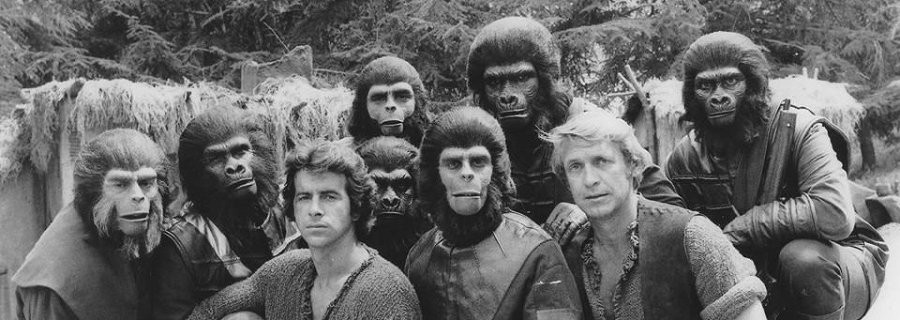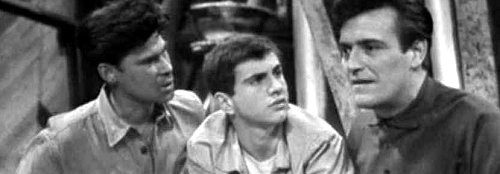
Raumpatrouille Orion
1966 - West GermanyReview - DT
"What may sound like a fairy tale today may be tomorrow's reality. This is a fairy tale from the day after tomorrow: There are no more nations. There is only mankind and its colonies in space. People have settled on faraway stars. The ocean floor has been made habitable. At speeds still unimaginable today, space vessels are rushing through our Milky Way. One of these vessels is the ORION, a minuscule part of a gigantic security system protecting the Earth from threats from outer space. Let's accompany the ORION and her crew on their patrol at the edge of infinity."
In 1966, a series began in West Germany which went by the none-too-snappy title of Raumpatrouille – Die phantastischen Abenteuer des Raumschiffes Orion, or, in English, Space Patrol – The Fantastic Adventures of Spaceship Orion. Understandably, the series is most often known as Raumpatrouille Orion, or just Raumpatrouille. The series is little known in the English speaking world, although in an unusual example of international cross-production, French language versions of the episodes were shot for broadcast on the French state channel ORTF. In the main, though, Raumpatrouille is best known in Germany and Austria, where it has developed something of a cult following.
Produced by Westdeutscher Rundfunk, or WDR, for broadcast on West German television, Raumpatrouille gives a rare insight into the futurism of Europe in the Cold War years. German entertainment media remains neurotic when it comes to reminders of the country's militaristic past. In 1967, with the nation still divided into East and West and with fallout from World War II still in people's minds, the fear of militarism was potent. The West German state channel ARD had criticism's about the militaristic nature of the setting of Raumpatrouille. This is a shame for, while it is a military setting, the future of the Space Patrol is resolutely optimistic. It seems to be precisely what a divided and recovering country needs to see.

In the distant future, national boundaries have been abolished, and a united government presides fairly over the Earth and its associated colony planets. The ocean floor has been colonised, and spacecraft patrol the skies, keeping the peace. One such ship is the Orion, under the command of Major Cliff McLane. Essentially a flying saucer, the Orion is, on the inside, a wondrous vision of speculative technology. This looks like the future, with gleaming interfaces at whose functions we can guess at. The optimism of this future is clear from the make-up of the crew. While Major McLane is American, his crew includes a Japanese navigator and star cartographer, a Scandinavian engineer, and an Italian computer specialist and armaments officer. This is clearly not a projection of a desire for a Teutonic world order. This is a world where all peoples are considered equal, albeit where the limits of casting in West Germany meant that all characters were portrayed by caucasian actors.
There is, of course, a very obvious similarity with another television drama series set in space. The setting of Raumpatrouille is fundamentally very similar to that of Star Trek. Astonishingly, the two series were developed, recorded, and first broadcast at almost precisely the same time. The German series premiered nine days after the American. It is Germany's answer to the same questions about the future that people worldwide were answering themselves. Twenty years after a world war, and with the world still divided, where do we go from here? Can it get better? The parallels are obvious – both series feature a military crew on what is ostensibly a peaceful mission. If anything, however, Raumpatrouille makes its case better. There is little hint of empire building, as there was in the early episodes of Star Trek. What's more, the claims of equality are reinforced on the Orion's bridge. Female crewmembers dress much as their male colleagues, and are treated with respect. While there is some flirting and banter, it is generally in good humour and is a good deal more restrained than much that you'd get today. There's a similarity between Dietmarr Schönherr's Major McLane and William Shatner's Captain Kirk. Both are handsome leading man actors, playing hotheaded but nonetheless wise commanders who don't always follow the rules. However, a better match for Kirk's womanising attitude is Lt. Mario de Monti, played by Wolfgang Völz, who comes across as something of a letch and is frequently shot down. It might have done Kirk some good to get a little of that sort of treatment.
While Schönherr is the star of the show, and admirably carries the focus of each episode, he has a charismatic leading lady in the form of Eva Pflug. Her character, Lt. Tamara Jagellovsk, is sent in to keep an eye on McLane, who has enemies in the Space Patrol command structure, who see him as a disruptive influence. Jagellovsk is a member of the Galactic Security Service, the military intelligence and policing agency, so it's no surprise when the crew take an initial dislike to her. Nonetheless, Pflug makes Jagellovsk a both formidable and likeable presence, and both viewer and crew soon come round to her. There's also an obvious sexual tension between her and McLane – obvious, but nonetheless subtly played.

McLane's impulsive command style leads to his demotion at the opening part of the series. Indeed, Space Patrol is not what this crew want to be doing – there's the clear sense that this is a menial mission and they'd rather be on the frontline. The crew stand by their commander, of course, having come to respect and follow him. De Monti is an old friend of his. Navigator Shubashi and engineer Sigbornson respect his decisions and appreciate the opportunity he has given them to prove that a dangerous manoeuvre can be performed – the very thing that just got them all demoted. Legrelle, the communications officer, not only respects McLane but harbours feelings for him, an aspect that makes it particularly hard to tolerate Jagellovsk at first. These six are the only crew; there are no low-ranking crewmen to deal with the dangerous parts of the mission.
The menial patrol duties do not last, of course. The peace that they have come to enjoy is threatened by the sudden appearance of extraterrestrial starships. The aliens, called Frogs by the military types, lead an unprovoked and vicious attack against the Earth forces. They even launch a planet at the Earth (or possibly a supernova – it's a bit vague). Particularly interesting, for those comparing the series to Star Trek, is that the Frogs are the first, and only, alien intelligence encountered by humanity. As McLane reminds Jagellovsk, there's no rulebook for dealing with an alien threat. It is perhaps the blindly violent alien Frogs that gained ART's objections. The other is enemy, something that could easily be read as lingering fascism. However, McLane, while he fights the Frogs, is only too keen to point out the Earth forces' hubris. They assumed that humans were the only intelligent life in the galaxy, and expanded without caution. McLane and his crew do what they can to try to convince their superiors to fight the impulse to engage in all-out war, and to try to communicate with the aliens.
The creators of the series produced a wonderfully inventive and memorable universe on meagre resources. While it is possible to spot some of the futuristic items for what they really are – plastic cups for lightbulbs, most famously – the ingenuity of the designers covers up most shortcomings. Indeed, the fact that the series was filmed in black and white can only have helped it, since monochrome film covers many sins. It is still, though, a rather beautiful, European sort of future, all flowing lines and gleaming surfaces. The Security Service's headquarters are a particular delight, not only realised as a rather opulent hotel-like setting, but positioned under the sea, complete with a Starlight Casino. The wonderfully odd sight of a hall full of people dancing like eels while huge fish swim above their heads is not easily forgotten. Indeed, the HQ seems like a very inviting place, which is odd considering what a tough time the Orion crew get there.
Only seven episodes of Raumpatrouille were ever produced. While it is said that creators W.G. Larsen and Rolf Honold only ever intended it to be a seven-part serial, further episodes were scripted. So why a second series was not produced is unknown. While ARD's objection to some of the content and themes may have had a bearing, it is more likely that the expense of the production put paid to any further instalments. In any case, while we saw McLane battle the threat of the Frogs and institutional corruption, save fellow spacecraft from destruction and renew their reputation, we never got a chance to really explore this world. The story didn't end there altogether, though. A series of science fiction paperbacks under the banner Terra Astra, which had already provided German translations of works by Isaac Asimov and Doc Smith, included adaptations of all seven episodes plus five original stories. The series was edited into a single movie, remastered and released in 2003. While welcomed by the series' fans, it failed to develop much new interest, although it does remain the version it is easiest to find with English subtitles.
Raumpatrouille provides an interesting parallel to the success of Star Trek and its stablemates in the English speaking world. Given further series, perhaps Raumpatrouille could have truly taken off and be better remembered today. It's even easy to imagine English language remakes if the series had been more successful. As it is, Raumpatrouille remains a curio, albeit one that is fondly remembered by many German sci-fi enthusiasts. It is garnering new admirers in the modern age of easy communication and fan groups. Indeed, until Star Trek finally arrived in West Germany in 1972, Raumpatrouille was Germany's best known look at the future.
Seen this show? How do you rate it?
Seen this show? How do you rate it?
Published on January 24th, 2019. Written by Daniel Tessier (2014) for Television Heaven.










